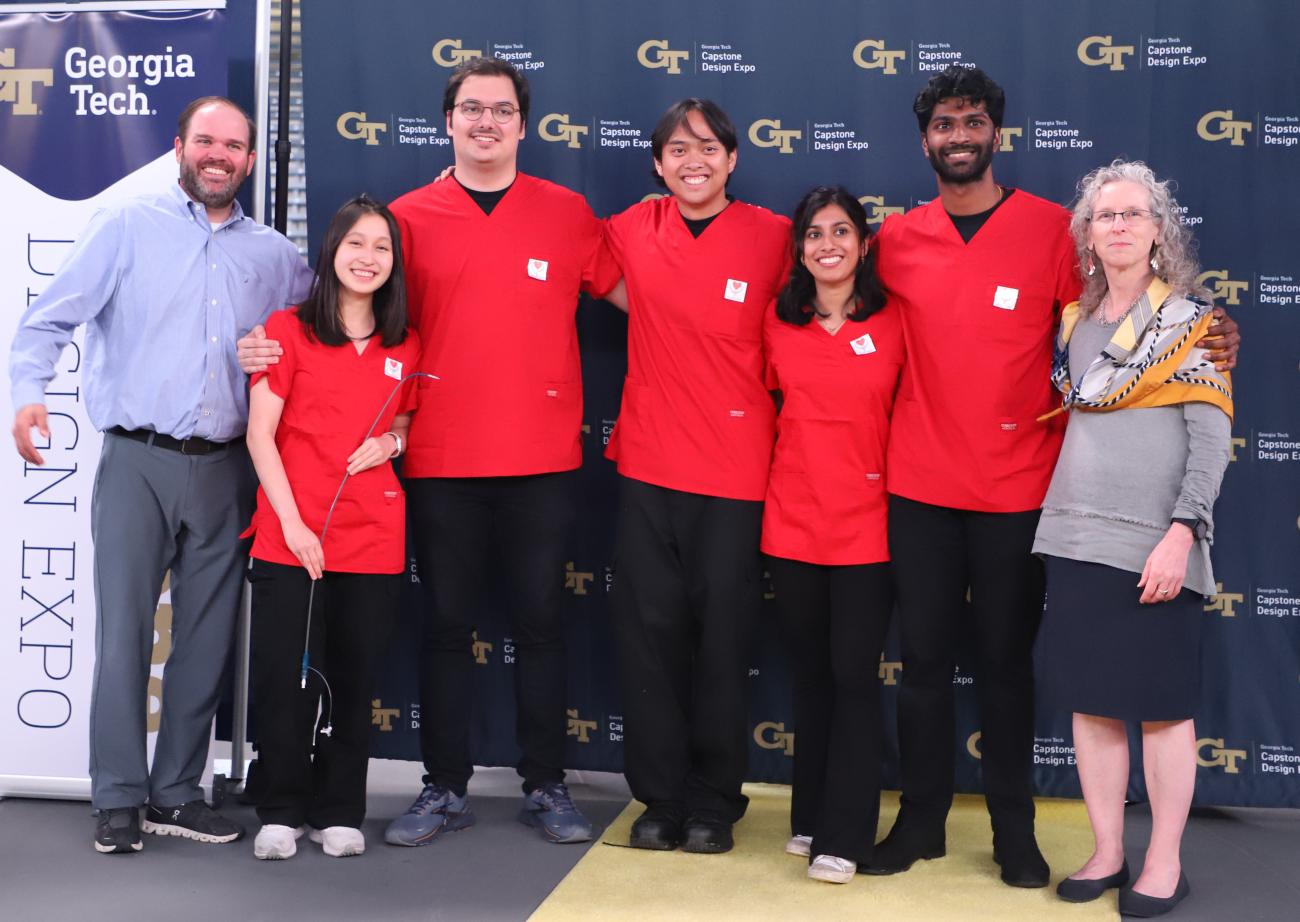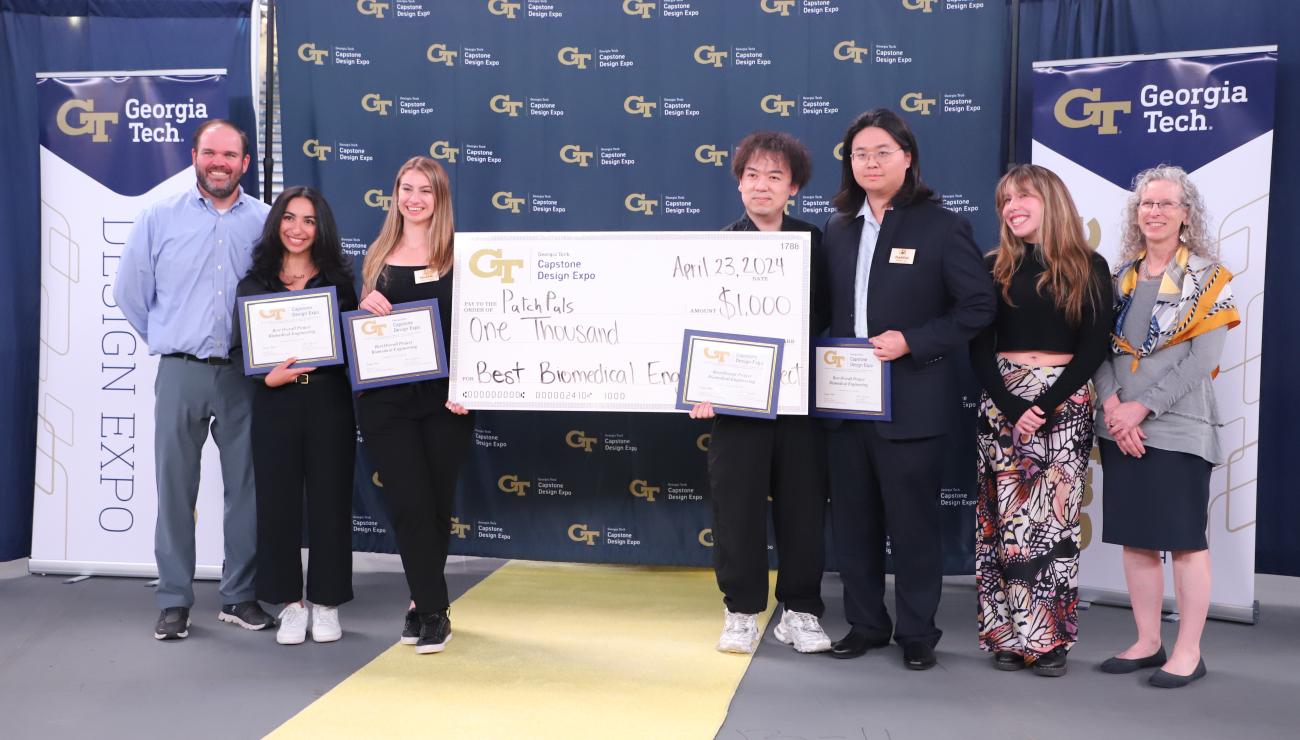By Jerry Grillo
Five students from the Wallace H. Coulter Department of Biomedical Engineering at Georgia Tech and Emory University developed a new medical tool to help patients after a standard treatment for atrial fibrillation goes awry. And it earned them a share of first place in the Spring 2024 Capstone Design Expo, Tuesday night in McCamish Arena.
The BME students, a team collectively known as Left Atrial Files, tied for the best overall project award with an interdisciplinary team called Seekr, that developed a wearable device to help visually impaired people navigate airports. The four students comprising Patch Pals took first place in the BME department category with their streamlined hospital wound care system.
Knowing that people with AFib are five times more likely to have a stroke, the Left Atrial Files had a clear sense of direction their tool, the EmPath. For many people with AFib, blood thinners do the job of preventing the clots that can cause a stroke. But for some patients, particularly the elderly, these drugs can be dangerous.
For them, there is a common procedure in which a Left Atrial Appendage Closure (LAAC) device is surgically inserted to close off the left atrial appendage, preventing clots from entering the bloodstream, reducing the risk of stroke. The procedure works well. But sometimes, the device becomes dislodged, causing dangerous chaos within the chambers of the heart.
“Our project was proposed by a physician whose patient had an LAAC device that was dislodged – the patient nearly died. So that was his motivation,” said Emily Yan, whose EmPath co-creators are Arda Yigitkanli, Jeremiah Sirait, Mitali Gupte, and Santosh Nachimuthu. They created a tool to safely retrieve a dislodged LAAC device.
Their device can be inserted into the same chute that surgeons use to insert the LAAC device. The retrieval tool features a tiny grasping claw and a net made from a superelastic material called nitinol. The claw grabs the errant device, and the net encapsulates it, then the claw pulls it back through the chute.
“We wanted to make something that would be able to save someone's life, in a situation like my grandpa’s, where the patient can’t take blood thinners,” said Yan. “Now if something goes wrong with a patient, there’s a tool that can help save them.”
The PatchPals originally set out to create team member Aya Samadi called, “a better band aid. But after interviewing a lot of people, we diverted toward focusing on negative pressure wound therapy, a process that is very time consuming, even painful.”
Negative pressure wound therapy, or NPWT, uses the controlled application of sub-atmospheric pressure, which reduces inflammation and promotes healing. Part of the procedure requires a clinician to cut a foam dressing to the approximate size of the wound, a trial-and-error procedure. PatchPals developed an efficient automated method for foam cutting, ultimately developing an NPWT procedure that is faster, leading to improved wound healing.
“We realized there’s an untapped field with many problems that we can improve,” said Samadi, whose teammates are Deniz Onalir, Shangze Lyu, and Xiaokun Xie.
Another team featuring four BME students and one ME student, the Arterial Avengers, were given Honorable Mention for designing RoboCath, a robotic arterial access device for catheterization procedures. They were one of the 204 teams competing in the Expo, which showcased senior projects from across the Georgia Tech campus.
Read complete coverage of the Spring Capstone Expo right here.
Latest BME News
Jo honored for his impact on science and mentorship
The department rises to the top in biomedical engineering programs for undergraduate education.
Commercialization program in Coulter BME announces project teams who will receive support to get their research to market.
Courses in the Wallace H. Coulter Department of Biomedical Engineering are being reformatted to incorporate AI and machine learning so students are prepared for a data-driven biotech sector.
Influenced by her mother's journey in engineering, Sriya Surapaneni hopes to inspire other young women in the field.
Coulter BME Professor Earns Tenure, Eyes Future of Innovation in Health and Medicine
The grant will fund the development of cutting-edge technology that could detect colorectal cancer through a simple breath test
The surgical support device landed Coulter BME its 4th consecutive win for the College of Engineering competition.









